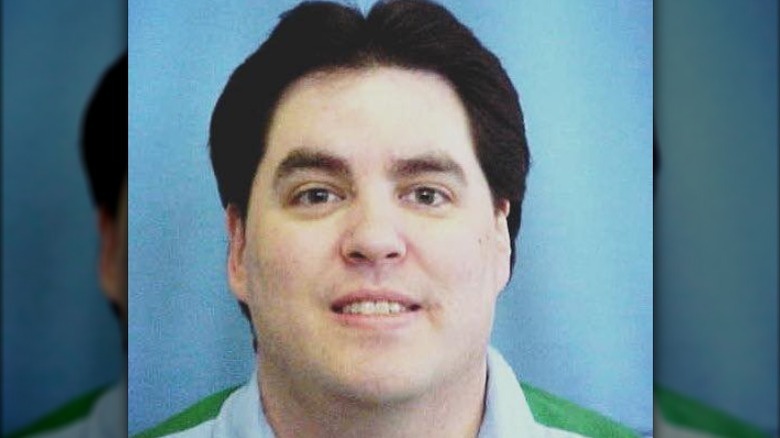How Did Serial Killer Paul Runge Find His Victims?
Serial killers will sometimes have unique ways to select their victims. Some, like Freeway Killer William Bonin, prey upon young hitchhikers. There have been some documented killers who have chosen their victims at random, as was the case with Richard Ramirez, who terrorized the people of Los Angeles as the Night Stalker in the early 1980s (via The Guardian). In one unusual MO, Richard Chase (aka the Vampire of Sacramento) selected his marks by trying front doors to see if they were unlocked.
Suspected of killing at least seven female victims, Paul Runge developed a dedicated method of choosing who he would kill. Runge would leave a dark mark on Chicago during his spree, as his destructive process would gather plenty of attention from both the authorities and the media, both of whom were aware that a serial murderer was on the loose in the city.
Runge's criminal history began when he was young, a prison sentence handed to him when he was only 17 years old (via Wickedness). A life that could have begun anew after his sentence was completed instead continued down an even more sinister path that he left littered with the bodies of his victims.
Runge was sent to prison as a teenager
Runge was not quite 18 when his mother died. Wickedness reported that this event had quite an impact on the teen. The Chicago Tribune details how Runge lured a 14-year-old girl to his home on the night of August 17, 1987, and held her captive for nearly 15 hours. During that time, the unnamed victim was bound by handcuffs and blindfolded.
When she finally escaped from Runge's home at 4 p.m. the following day, she detailed her nightmarish experiences to the police. She had been repeatedly raped by Runge, who had also cut her across her stomach with a knife. When he had at last finished with her, he forced her into a sleeping bag and stuffed her into the home's crawlspace. After freeing herself, she fled to a nearby home and alerted the police.
Police began their search for Runge immediately, almost apprehending him at a local shopping center. But Runge fled, managing to evade capture. After a week and several phone calls from Runge to the police, he agreed that it would be in his best interest to turn himself in. Police arrived at an address given to them by Runge and he was arrested without incident. Convicted of his brutal crime, Runge was sentenced to 14 years in prison, perhaps with the hope that he would be a reformed man upon his release (via Find Law). Paroled seven years early in 1994, it didn't take long for Runge to re-offend. But instead of just a rapist on the loose in Chicago, the city now had a bloodthirsty killer to reckon with.
One victim was found by a dog
Runge's first three murder victims did not fit the MO he would be later known for. The first woman he is known to have murdered was 25-year-old Stacy Frobel, who was last seen paying a visit to Runge's home in the Chicago suburb of Streamwood. Since his parole from prison, Runge had married and secured employment as a shoe salesman. Frobel was a friend of Runge's wife Charlene and was reported missing by her husband when she didn't return from the Runge household (per The Chicago Tribune). It's reported that when Frobel entered the home, Runge struck her on the head, instantly killing her. He then carried her body into the bathroom and placed it in the bathtub. Using a saw, he dismembered her body, scattering the pieces in a nearby field.
Several days later, a German shepherd found one of Frobel's legs and carried it home to his owner. The dog found the second leg soon after, bringing yet another unexpected find home. This development was enough to get the authorities more interested in Runge as a suspect, and soon they were probing his possible involvement in double murder.
Dzeneta and Amela Pasanbegovic were Bosnian refugees who sought a better life in America. They had arrived in Chicago not long before they started their own housecleaning business. Unfortunately, they were hired by Runge and were last seen alive on July 11, 1995. Believing Runge was responsible for their disappearance, the FBI arrived at his home to interview him.
Runge began to target women he found in the local classifieds
The Chicago Tribune reports that the purpose of the FBI's visit was to try to look for evidence that would tie Runge to the murders of Frobel and the Pasanbegovic sisters. Runge voluntarily allowed the agents to search his home, who took with them some 200 items as potential evidence. Among this cache of material were a stun gun, a crossbow, and a large hunting knife. Additionally, the agents rummaged through Runge's trash and located a piece of stationary with his employer's logo, with the contact information for the Pasanbegovic sisters written on it. It would later be revealed that his possession of the knife would have been enough to have put him behind bars immediately, saving four lives.
Not to be deterred from his newfound bloodlust, it didn't take long for Runge to settle in and work to get victims with a new modus operandi. From January until March of 1997, Runge would lure his final four known murder victims to their deaths using ads that they had each placed in the classified section of the local paper.
A weapons violation resulted in his arrest
Thirty-year-old Dorota Dziubak had placed an ad in the classified section of her local paper in hopes of selling her house. Instead, she was introduced to Runge. After responding to the ad, Runge was able to gain the confidence of Dziubak, gaining entry into her home. He raped and strangled the woman, then set her house on fire. The Chicago Tribune reports that this January 1997 murder would be far from his last.
Find Law tells us that on February 3, Runge responded to yet another classified ad. This time, it was one placed by 45-year-old Yolanda Guitierrez, who was trying to sell used "Hooked on Phonics" material. Runge entered her home, which she shared with her 10-year-old daughter Jessica Muniz. Runge bound the mother and daughter and forced them on a bed. He viciously raped each of them over several hours, leaving behind plenty of DNA evidence. After slashing their throats, Runge doused the bed and the floor around it with some sort of accelerant and lit the house on fire.
Runge's final victim was 43-year-old Kazimiera Paruch, who had placed an ad in an attempt to sell her condominium. Runge met with her at her home and delivered to her the same fate as his previous three victims. When his crimes against Paruch were finished, he lit her home on fire. The FBI notified the state that they had retrieved a knife from Runge during their 1995 search of his home. This was enough for authorities to finally arrest him for a weapons violation.
Runge was initially sentenced to death
While being held for violating his parole, the state petitioned to have Runge detained indefinitely under the Sexually Violent Persons Act. This petition would later be withdrawn, however, as DNA evidence would finally link Runge to several of his murders.
While in custody for the weapons violation, he was questioned by Chicago police department Detective Frank Cappitelli in June 2001. When confronted by the detective, Runge was insistent that he was innocent. But he changed his tune when Cappitelli presented him with the forensic evidence. Runge's DNA was identified as that left behind by the man who assaulted both Guitierrez and Muniz. Perhaps knowing that his number was up, he told Cappitelli, "You know I did it, you got me" (via Find Law).
In a 2006 trial, Runge was found guilty of two charges of first-degree murder stemming from the Guitierrez and Muniz homicides. The jury sentenced him to death (via The Chicago Tribune). But when Illinois Governor Pat Quinn abolished the death penalty, Runge's death sentence was commuted to life in prison without the possibility of parole. After consulting with the family members of Runge's other known victims, the state dropped the pending murder charges against Runge. As he will be in prison for the rest of his natural life, this will spare the families the agony of potentially long trials and appeals (per CBS News Chicago).





